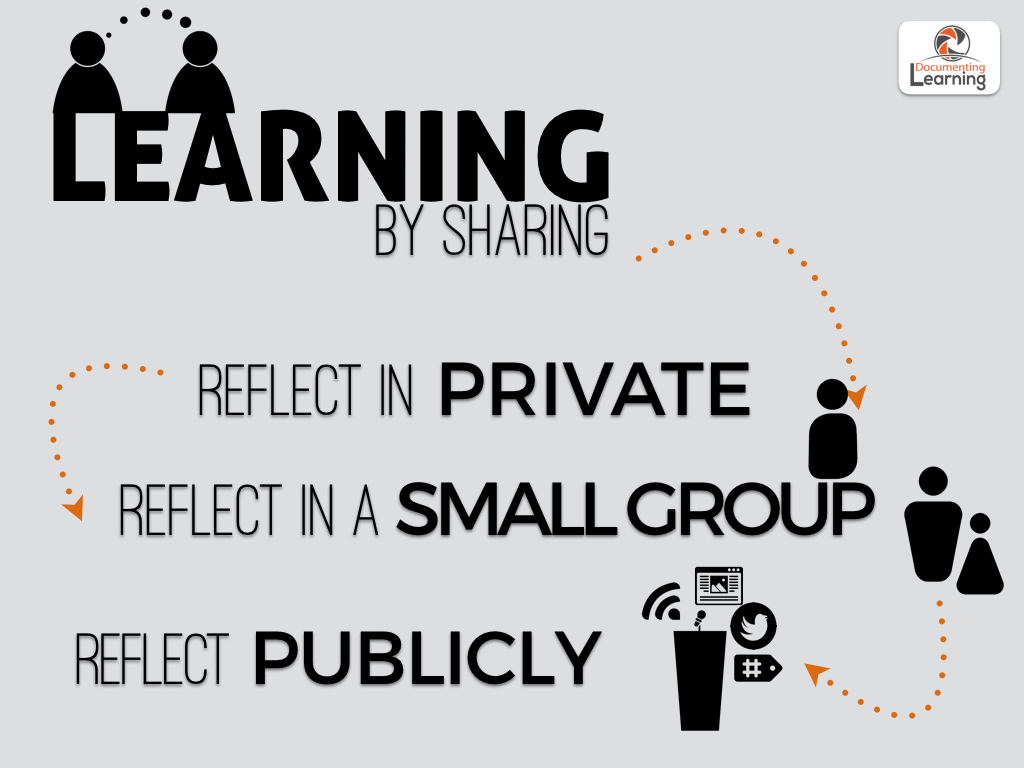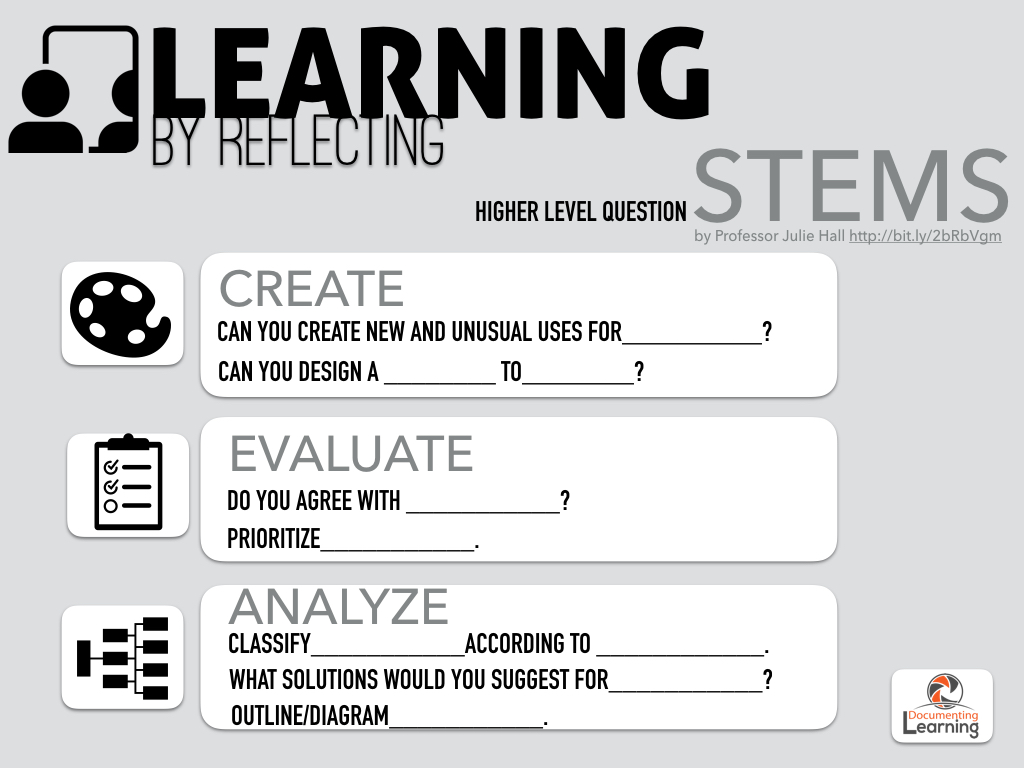Reflection is an important component of the learning process. Reflection cannot be seen as an add-on, something to be cut out if time is running short. Unfortunately, that is precisely what happens too often.
Reflection also plays an important role in documenting learning, blogging as pedagogy, and formative assessment. Asking a learner to reflect on his or her experience, a teacher to reflect on a lesson taught, or a student to reflect on a new concept will often be met with blank stares. The ability to reflect is a skill to be learned, a habit to develop. Reflection requires metacognition (thinking about your thinking), articulation of that thinking, and the ability to make connections to past, present, future, outliers, and relevant information.
In addition to inherent components of reflection, which traditionally have been viewed as internal (thinking about one’s own learning and that thinking primarily benefiting ourselves), it is important to amplify our reflection by sharing them transparently (learning how to articulate our thinking and make that thinking visible to others, which in turn benefits ourselves and others). By sharing our reflections beyond a teacher or colleague, we acknowledge our voice as learners and the role it plays in a collective learning process.
In Challenge 17 you will amplify your reflection about a self-selected topic or idea from a book, conversation, movie, TED talk, experience related to your work, or professional passion. Be creative in your choice! Don’t just think about what your selection means to you in your own mind, but share with an audience greater than one and:
- articulate your thoughts and connections to other areas of your work or experiences you have had pertaining to your self-selected topic.
- use a reflection strategy that works for you, or choose from one of the four strategies included below.
- be metacognitive about how you learn when you are in the act of learning. How do you regulate/maximize your learning?
Follow these steps to complete this challenge:
- Use your selected reflective strategy or strategies to unpack your selected product (e.g., book, infographic) or performance (e.g., interview video, TED Talk). If desired, create a learning-thinking documentation artifact that captures what you have realized, are questioning, or wondering based on your reflective process.
- Write a new blog post and include a narrative that articulates your metacognitive, reflective process and how it affected your thinking deeply about your selected product’s or performance’s topic focus. If appropriate, embed your learning-thinking documentation artifact(s).
- Title, save, and publish your post.
After you have completed your challenge to create a Amplify Your Reflection blog post, please include the URL link to your post with embedded media, if appropriate, in the Leave a Reply comment section below to share with us and your documenting community. Check back regularly to see what others have posted!
Added Amplification: Tweet or share on Instagram the link to your Amplify Your Reflection blog post. Be sure to include the hashtags #documenting4learning, #AmplifyYourReflection, and #DLBloggingChallenge17, as well as any appropriate hashtags for your learning topic.
Here are a four reflective strategies that support growing as metacognitive and connective learners:
Strategy 1 – The Reflective Teacher: A Taxonomy of Reflection by Peter Pappas
Pappas observes:
Reflection can be a challenging endeavor. It’s not something that’s fostered in school – typically someone else tells you how you’re doing! Teachers are often so caught up in the meeting the demands of the day, that they rarely have the luxury to muse on how things went. Moreover, teaching can be an isolating profession – one that dictates “custodial” time with students over “collaborative” time with peers. In an effort to help schools become more reflective learning environments, I’ve developed this “Taxonomy of Reflection” – modeled on Bloom’s approach.

Bloom’s Creating – Reflection: What should I do next? What’s my plan / design?
Bloom’s Evaluating – Reflection: How well did I do? What worked? What do I need to improve?
Bloom’s Applying – Reflection: When did I do this before? Where could I use this again?
Bloom’s Analyzing – Reflection: Do I see any patterns or relationships in what I did?
Bloom’s Understanding – Reflection: What was important about what I did? Did I meet my goals?
Bloom’s Remembering – Reflection: What did I do?
Strategy 2 – Four Dimensions of Reflective Learning by Karen Barnstable
Barnstable shares:
It is my hope that the four dimensions of reflection will add to your body of knowledge about a learning experience and contribute to your general understanding of yourself a
s a learner and a uniquely gifted person.
- I. Thinking Back
- II. Thinking Forward
- III. Thinking Inward
- IV. Thinking Outward
You may also want to take a look at 40 Reflection Questions (by Edutopia) to help you look backward, inward, outward, and forward.
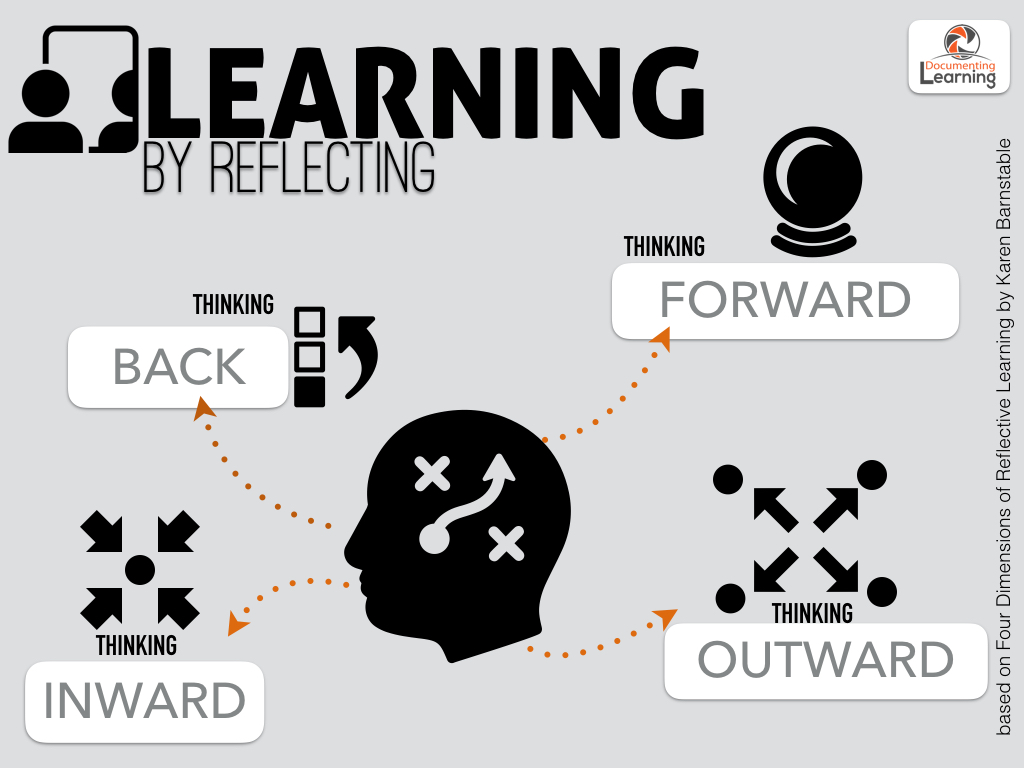
Strategy 3 – What? So What? Now What?
- What?
- Describe the experience; outline what happened that compelled you to think about and change your behavior (i.e. learn).
- So What?
- Describe what difference it makes; outline what impact or meaning it has for you (or why it should matter to others).
- Now What?
- Describe what’s in store for the future now that you’ve learned from this experience; outline what you are going to will do to continue learning.
Strategy 4 – Higher Level Question Stems from Bloom’s Taxonomy by Professor Julie Hall
Create:
- Can you create new and unusual uses for__ __?
- Can you design a__ __to____ ?
Evaluate:
- Do you agree with___ _?
- Prioritize ____
- How would you decide about__ __?
- Classify_ _ __ according to_ _ __.
- What solutions would you suggest for__ __?
- Outline/diagram__ _ _.
